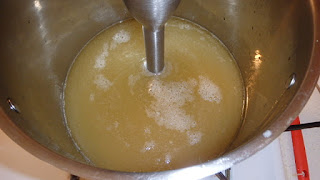I start the process by making the "water" portion of the soap. First I make a small pot of chamomile tea and while it cools, I measure out the aloe and the cucumber for the batch of soap. Everything used to make the soap is measured in ounces and I do my best to record the amounts used so I can repeat the recipe when I want to. I puree the aloe and cucumber in a blender and then add the chamomile tea until I reach the desired amount.
After that I carefully measure out the lye and add it to the water mixture slowly. Lye is very caustic, so I make sure that I am wearing protective clothing, gloves and goggles when I am handling this mixture. Adding the lye to the water causes an exothermic reaction and the mixture gets very hot, very quickly - over 180 degrees in seconds, so I cool it in an ice bath to bring the temperature down to 125 degrees.
Meanwhile, I measure out and melt the fats I will be using in my soap. I use a mixture of beef tallow, palm oil and coconut oil in my soap. I have used other oils, but I like the firmness of the bar that I get from this combination.
Once the fats get close to the mixing temperature of 125 degrees, I turn off the heat and slowly add the lye mixture to the fats and begin to mix them together using a stick blender.
It takes some time, but the mixture eventually thickens as saponification begins to occur. Once it reaches trace I add in the ground oatmeal and mix it a little bit longer. After everything seems well blended I pour the soap into my mould.
Here it rests for 24 hours until it is firm. Then I remove the soap from the mould and cut it into bars and line them up on the counter to cure. The curing process takes two to six weeks to complete.
This much soap would easily last me over a year, but I like to give some away during the holidays so I will most likely make a few more batches before the year is over.
Making soap is a fairly simple project and only takes a little time to make a large quantity of soap. It is also an inexpensive project if you have all the equipment that you need. I have a box of supplies dedicated to making soap that includes everything I need, like the mixing pot, the thermometer, the stick blender and other utensils. My only costs for making soap now are the oils and other ingredients, though I get the cucumber and aloe for free out of my garden. I usually order my oils from a soap making supplier online since I can buy small batch quantities for a decent price with little hassle. This batch of soap cost me less than $15 for 24 3-4oz bars of soap. Not a bad price to pay, and I know exactly what went into making this soap - no added chemicals, fragrances or dyes. This soap is just soap and it doesn't dry out my skin like so many soaps that I have tried in the past. I have to say that I have been so happy with the results, that I haven't used store bought soap in over five years.






No comments:
Post a Comment